Back to List
THE SLS/MLS RAILTOURS
15: The West Durham Railtour 1958. (W614)
This tour, which ran on the 31st of August 1958, featured rebuilt Scot number 46143 'The South Staffordshire Regiment' on the connecting service to and from Manchester Exchange and Peppercorn K1 number 62059 on the main railtour from Darlington and around the north east.
In the very first edition of The Mancunian, the journal of the Manchester Locomotive Society, there is a splendid account of the journey from Manchester by the then President, Doug Darby, which is reproduced below.
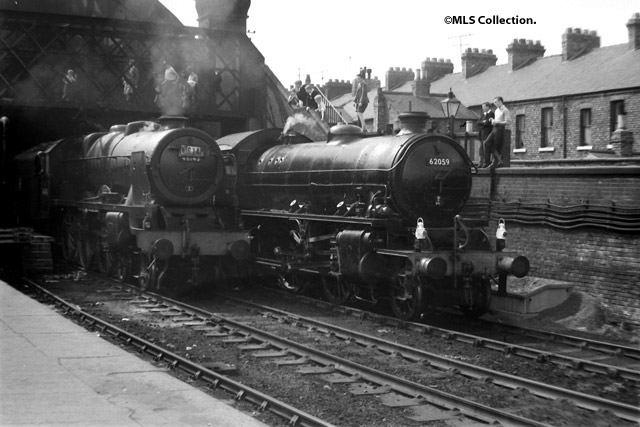
The two participating locomotives of the railtour - rebuilt Royal Scot No. 46143 ' The South Staffordshire Regiment' and Peppercorn designed K1 class 2-6-0 No. 62059 line up at Darlington Bank Top.
SOME RANDOM IMPRESSIONS OF THE WEST DURHAM RAILTOUR. by J.D. Darby.
After a lamentably wet summer it was delightful to have a perfect summers day for the West Durham Railtour. Our anticipation of an enjoyable day was further enhanced when the train engine was seen to be a gleaming 'Scot' which carefully brought our long train round the curves out of the morning sun into the dingy interior of No 5 platform at Exchange.
"At least we should get a good run to Darlington" the pundits were heard to remark and earnestly prepared their stop watches. They were not disappointed. After the usual frustrating start as far as Stalybridge, 46143 got moving to some tune and stormed up the bank to the summit in fine style. "48½ m.p.h" announced our chief timer, who was suitably ensconced in a strategic position over a bogie. This was a very good effort with an 11 coach train of around 330 tons on such gradients and compared more than favourably with the typical 35 m.p.h of a regular 'express'.
The inevitable check occurred outside the entrance to Standedge Tunnel which was entered at little more than walking pace. Once clear of this three miles of stygian gloom, however, acceleration was rapid and we shot down to Huddersfield at a maximum of 70 mph, again an unusually high speed for this route.
Having safely emerged from the sulphurous murk of Huddersfield Tunnel we quickly cleared the station and took the Spen Valley route to Leeds. The journey so far had been exhilarating but it was tame compared with the next stretch. Rarely could the Spen Valley line have been covered so quickly! 46143 whisked our 11 coaches around the sinuous curves, up hill and down dale, as though on a switchback railway. So hectic was the pace that the table, at which the writer and his entourage were seated, began wobbling ominously and was in danger of collapsing. A stategic withdrawal was effected, therefore, to a more substantial piece of furniture. This manoeuvre was completed just in time for shortly, on a particularly vicious bend, the abandoned table collapsed onto the floor.
The result of this exciting travel was that we gained 9 minutes between Huddersfield and Leeds, completing this tortuous section in 25 minutes. The maximum speed was 66mph.
In view of the breathtaking nature of the journey to this point speculation was rife as to what speed 46143 would attain on the glorious racing track between York and Darlington, the scene of so many speed exploits by the Gresley 'Pacifics'. The North Eastern pilot driver, who came on at Leeds, evidently found a 'Rebuilt Scot' to his liking for he was soon bowling along at 80-82mph. Pretty good going for a driver who hadn't handled this class of loco previously. This was the most enjoyable part of the trip, speeding across the Plain of York at 80mph, in the beautiful morning sun behind, for this line, an unusual class of engine. The net result of all this lively travelling was that a late arrival in Huddersfield of about 21 minutes was converted into a punctual arrival in Darlington, a very satisfying experience.
The engine for the rail tour proper was a spotlessly clean K1 no. 62059. This set off on time with a reduced load of five coaches and for the next five hours sedately covered all the lines laid down in the programme.
It is not the purpose of this brief review to be highly technical or historical (these aspects were admirably covered in the notes supplied by the Rail Tours Sub Committee), but to attempt to capture the atmosphere of the occasion. It was a day on which the countryside could be enjoyed as well as the railway. This was particularly so on the Waterhouses Branch.
As usual we attracted a lot of attention from the local inhabitants, no doubt providing a relief from the deadly boredom of Sunday afternoon telly. "Old men and babes in arms" came to stare with expressions of mingled astonishment and amusement.
So we plodded on through the languid heat of the afternoon via Lanchester and the huge steelworks at Consett to Scotswood where the engine ran round the train. On to Low Fell where another reversal was effected before continuing to King Edward Bridge Junction, thence threading our way gingerly through the tangled, sooty area of Gateshead Shed and Works to arrive at Pelaw. From this point the old main line was taken via Washington to Ferryhill on the main line, in effect the end of the actual tour.
Then the fireworks started! Our K1 had been enjoying it's gentle Sunday afternoon jog-trot through the County of Durham, so much so that it dropped a little time between Washington and Ferryhill. The footplate staff realised they could not make Darlington on time except by a superhuman effort. Soon after leaving Ferryhill, 62059 suddenly threw its torpor and began roaring like an angry bull. Faster and faster we sped along to the accompaniment of a shower of cinders on and in the train. Soon the speed was 70mph. With 5'2" wheels! By dint of this magnificent effort we were only 3 minutes late into Darlington. This will surely be the high spot of 62059's career!
Our speedy "Scot" took over and once again reached 80mph before shutting off for Northallerton. Leaving York about on time a punctual arrival would have been effected in Manchester except for a long irritating delay, a signal check at Micklefield and infuriating fiasco at Leeds. Our steed required water so the operating staff promptly ran us into a platform with the water column out of order due to the lack of the leather "bag". The result was 46143 had to uncouple and be manouvred into an adjacent platform with a water column. This operation was further complicated by a 2-6-4T which was annoyingly parked in front of the column. The crew of the latter were nowhere to be found so the thing had to be shifted by 46143's crew before they could "put the pipe in". A punctual arrival in Manchester was no longer possible now. Furthermore, our "Scot" seemed to have had the stuffing knocked out of it by this performance and only made an average sort of run home. Even so, we were only 20 minutes or so late which was tolerable for a Sunday night. One gathers it was a vast improvement over a certain infamous performance some two years ago.
Thus ended a particularly enjoyable rail tour which had combined lines of great interest with some lively main line running in perfect weather.
Editor's Note. The pilot driver on alighting from 46143 was heard to remark that our speed might have been even higher if the engine had been steadier. Apparently she began to roll a lot after Northallerton. This has always been a fault with the rebuilt "Royal Scots" and was the subject of investigation some years ago when no. 46120 worked between Derby and Manchester with the Dynamometer Car. A cure however does not seem to have been found.
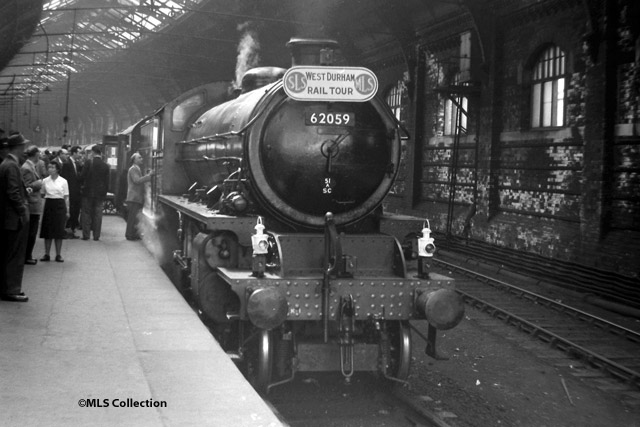
62059 at Darlington Bank Top station
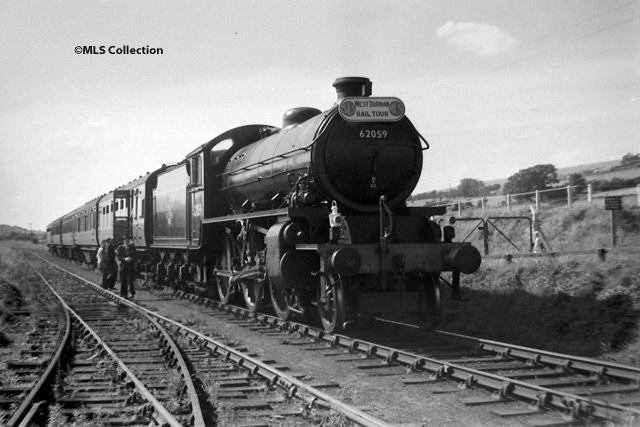
62059 pauses at Waterhouses Goods with the tour train.
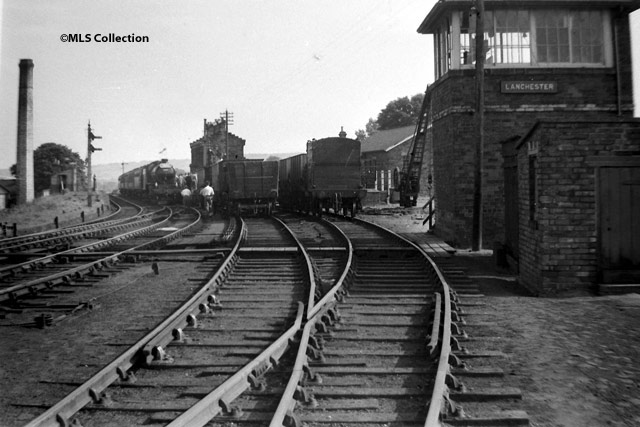
Lanchester station and signalbox with 62059 and the special.
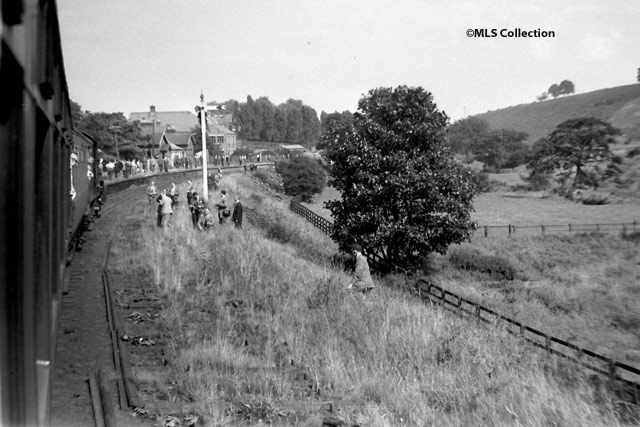
The view from the train on the approach to Waterhouses Station.
The narrative for this article was taken from the Mancunian of November 1958, Vol.1 No.1. All of the photographs used were taken by Harold Bowtell.
Last update December 2023. Comments welcome: website@manlocosoc.co.uk